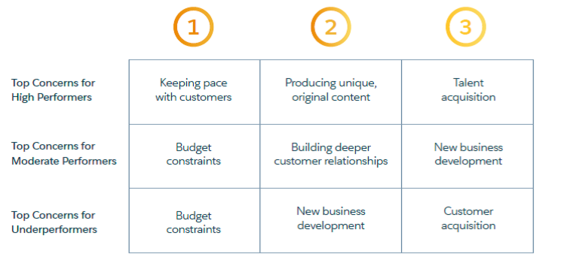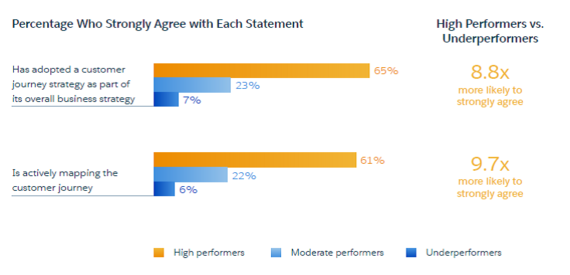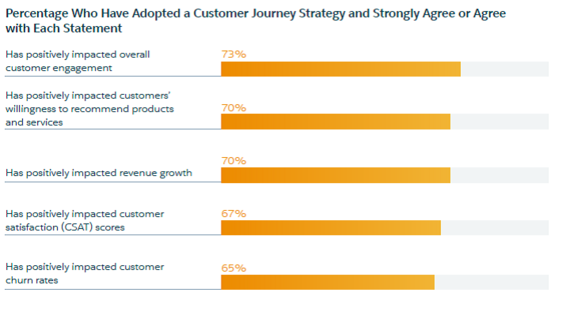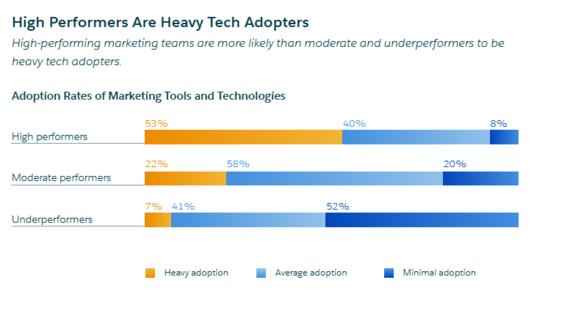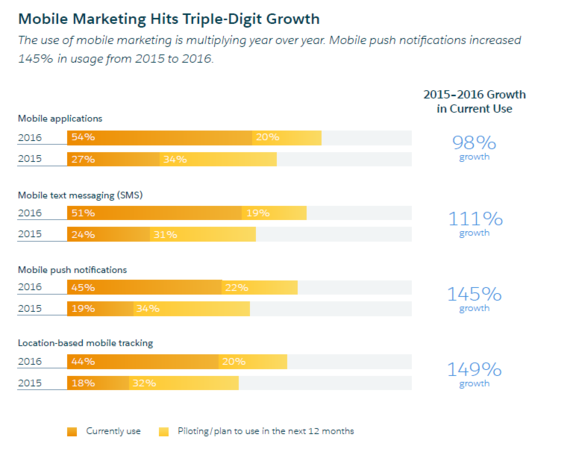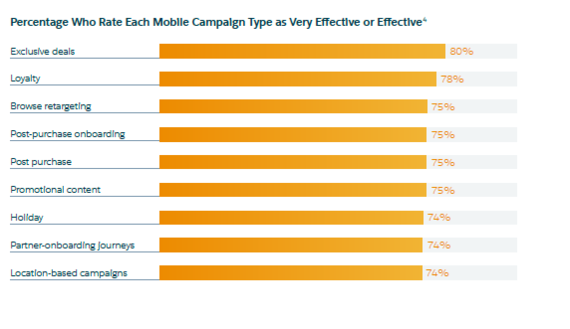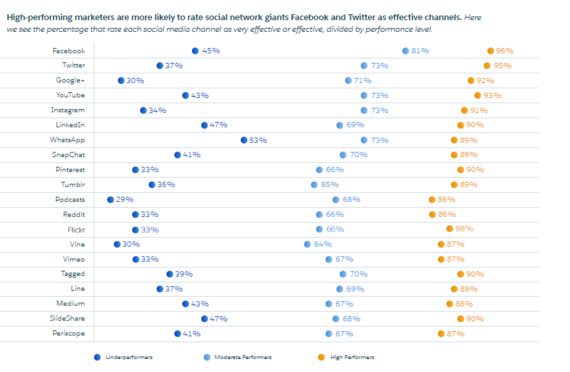"The CMO's currency is the customer - customer voice, customer value, valence, and often, the experience itself." - Jake Sorofman, Gartner Vice President. Sorofman notes that CMOs are finally getting respect in business, pointing to CMO tenures which have doubled to 48 months over the past decade. Sorofman also reflects on the scope of customer experience management and the key role of CMOs to design the desired-state experience, and align other line-of-business leaders, serving as de-facto chief customer officer.
What do CMOs and marketing leaders need to know about the changing role of marketing and key digital marketing transformation trends, priorities, and ROI metrics? To learn about the state of marketing in 2016, Salesforce surveyed nearly 4,000 marketing leaders were surveyed worldwide in order to learn more about:
- Overall trends changing the role of marketing
- How high-performing marketing teams approach the customer journey and experience
- Gain key insights on primary digital marketing channels
According to the global marketing research, there are nine key findings:
- Top teams win with a customer journey strategy. High - performing marketing teams are 8.8x more likely than underperformers to strongly agree that they've adopted a customer journey strategy as part of their overall business strategy. Successful marketers are connecting with customers in new ways across mobile, email, social, and the web.
- Top teams are integrating the customer experience. Successful marketing leaders are crossing the boundaries of business units to create a single view of the customer. High-performing marketing teams are 7.7x more likely than underperformers to strongly agree they're leading customer experience initiatives across the business -- bridging the gap between marketing, sales, and service.
- Top teams get smart with tech adoption. To keep pace with a dynamic industry and continually make marketing communications smarter, 72% of top teams will increase spending on marketing tools and tech in the next two years.
- Mobile hits a tipping point. From 2015 to 2016, every aspect of mobile covered in this research has risen significantly in usage. With 98% growth in mobile app usage and 111% growth in SMS usage, a majority of marketers are now using these mainstream mobile tactics to engage customers.
- Real-time channel orchestration strikes a chord. Leading marketers understand the value of a cross-channel approach. Top teams are 3.2x more likely than underperformers to strongly agree they've integrated their social media activity into their overall marketing strategy.
- Top teams align marketing with business leadership. The world's best marketing teams have buy-in from company leaders. As such, marketing budgets are more likely to be prioritized.
- Intelligent email is driving higher revenue. As email personalization capabilities grow more sophisticated, the channel becomes even more integral for marketers to deliver a holistic customer journey.
- Social sees massive ROI growth. 75% of marketing leaders report that social is generating ROI.
- Advertising accelerates on social platforms. Nearly two-thirds of marketers are boosting budgets for advertising on social platforms in 2016, making it the third largest area for increased investment.
To learn more about the Salesforce State of Marketing 2016 research, you can visit here.
Based on my analysis of the research, I was able to identify 55 important statistics that define key characteristics and strategies of high-performing marketing teams - I have categorized these stats based on a variety of topics including budget, digital channel, culture and leadership traits, and adoption of technology. Here are the 55 key marketing stats:
Priority and success measures:
1. Customer satisfaction is marketer's first measure of success (35%), followed by revenue growth (33%), and customer acquisition (24%)
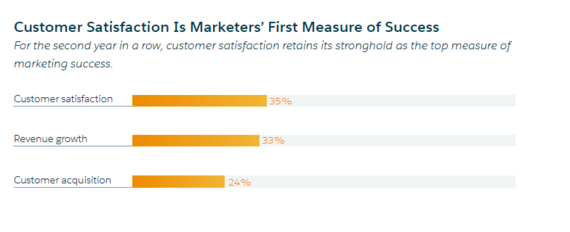
Figure 1: Marketing priorities
2.Marketers make customer engagement a top priority with the following goals: brand awareness (37%), higher level of customer engagement (34%) and social media engagement (25%).
3.Top 3 concerns for high performing marketing leaders: 1. keeping pace with customers, 2. producing unique, original content, 3. talent acquisition.
Marketing Alignment with Business Leadership
4.Executive team commitment makes a difference - high performing marketing teams are 2.6X more likely to say their executive team is completely committed to the overall marketing strategy.
5.Top teams prioritize marketing budgets - higher performers are 2.8X more likely to substantially increase spend on marketing tools and technologies.
6.Top performing teams are 3X more likely to substantially increase spend on digital marketing compared to underperforming marketing teams.
Marketing Budget Trends:
7.2016 marks a tipping point with marketers spending more than two-thirds (70%) of their total budget on digital marketing channels.
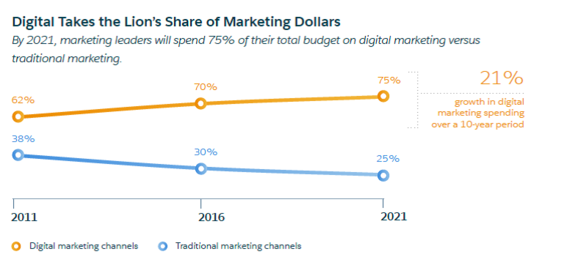
Figure 3: Digital marketing budget forecast
8.By 2018, 97% of marketing leaders plan to increase or keep current budget levels on digital marketing.
9.From 2011 to 2021, marketing leaders will see 21% growth in digital marketing spend.
10.By 2021, marketing leaders will spend 75% of their total budget on digital marketing versus traditional marketing.
11.Social advertising claims top spot for spending growth - percentage who are increasing spend in each category over the next 12 months: 67% social marketing, 67% social media engagement and 65% advertising on social platforms.
Customer Journey Strategy:
12.88% of high-performing marketing leaders say customer journey strategy is critical to the success of their overall marketing.
13.High performing marketing leaders are 8.8X more likely to adopt a customer journey strategy as part of the over business strategy.
14.High performing marketing leaders are 9.7X more likely to actively map the customer journey - 61% are actively mapping journeys.
15.Customer journey adoption drives powerful, positive ROI - percentage of high performing marketing leaders that believe customer journeys improve customer centric KPIs.
Integrating the Customer Experience
16.High performing marketing teams are 7.7X more likely implement digital transformation across the company and lead customer experience initiatives across the business.
17.Among high-performing marketing teams, 63% are excellent at collaborating with other business units (17.1X more likely than underperforming marketing teams) - bringing together marketing, sales, services, IT, and other executives.
18.High performing marketing teams are 13.7X more likely to create a single view of the customer. 64% of high performing teams say they are excellent at creating a single view of the customer versus 4% of underperforming marketing teams.
19.Top teams excel at creating omni-channel experience - high performing marketing teams are 34.4X more likely to create an excellent personalized, omni-channel experiences across the business units.
20.Top marketers lean on CRM tools - high performers are 3.3X more likely than underperforms to use CRM tools extensively, giving marketing, sales and service team a shared, single view of the customer.
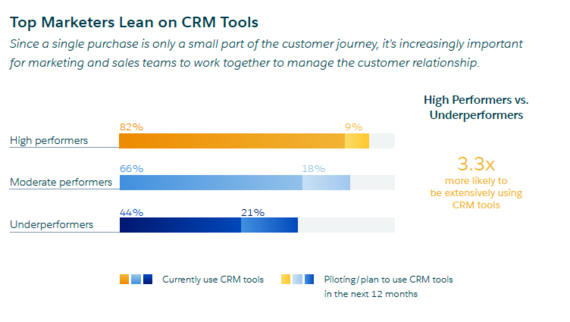
Figure 6. Top marketers lean on CRM
21.Predictive intelligence fuels a smarter view of the customer - top teams are 3.6X more likely to strongly agree that predictive intelligence and data science are important to their overall marketing strategy.
22.High performing marketing teams are 10.7X more likely than underperforming teams to extensively use predictive intelligence.
Key takeaway is that high performing marketing teams are more collaborative, data-driven, and leverage CRM technologies to deliver a single view of their customers to the entire company.
Tech Adoption:
23.Among marketers at all performance levels, 63% will increase spending on marketing tools and technology over the next two years.
24.High performance marketing teams are 2.8X more likely to substantially increase spending on marketing tools and technology.
25.53% of high performers qualify as heavy tech adopters compared to only 7% of underperformers.
26.On average, top marketing teams use more than twice the number of tools and marketing technologies than underperformers use.
27.High performing marketing teams see the impact of advanced technology:
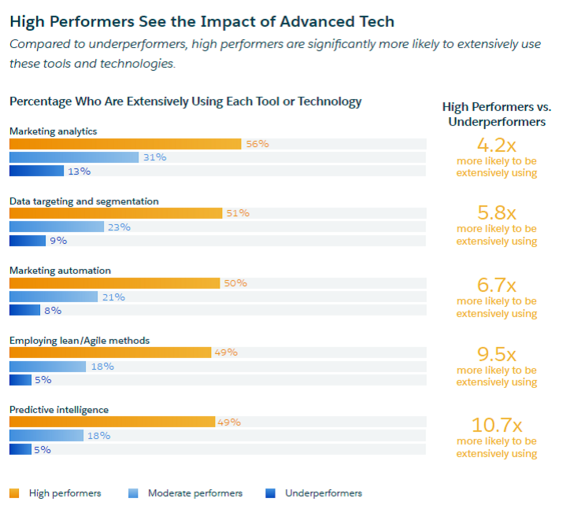
Figure 8: The impact of advanced marketing technology
a.Marketing analytics - 56% (4.2X more use versus underperformers)
b.Data-targeting and segmentation - 51% (5.8X more use versus underperformers)
c.Marketing-automation - 50% (6.7X more use versus underperforms)
d.Employing lean / Agile methods - 49% (9.5X more use versus underperformers)
e.Predictive Intelligence - 49% (10.7X more use versus underperformers)
28.The Internet of Things (IoT) is an emerging technology priority for high-performing marketing teams - 15.4X more likely use of IT for high performing teams versus underperformers.
29.Emerging technologies for high performing marketing teams:
a.Proximity marketing using beacon technology - 85%
b.Internet of Things - 45%
c.Podcasting - 85%
d.Wearables - 82%
Several of the emerging technologies referenced in the research, including IoT and wearables, will fuel the real-time, personalized marketing in several industries including retail, entertainment and hospitality. Marketers will leverage user identity, location data, and time of day to significantly enhance the user experience with mobile apps running of wearables (or smartphones) as engagement vehicles.
Marketing Channels - Real Time Channel Orchestration
30.82% of high performing marketing teams consider advertising on social platforms to be part of their mobile marketing efforts.
31.Integrated channels prove highly effective for top teams
a.95% integrated email marketing strategy into overall marketing strategy (19% underperformers)
b.96% integrated mobile marketing strategy into overall marketing strategy (12% underperformers)
c.98% integrated social media marketing into overall marketing strategy (20% underperformers)
Mobile ROI
32.Mobile marketing hits triple digit growth - the use of mobile marketing is multiplying year-over-year.
33.Mobile push notifications increased 145% in usage from 2015 to 2016.
34.Mobile marketing increases from 2015 to 2016:
a.Mobile applications grew by 98%
b.Mobile text messaging grew by 111%
c.Mobile push notifications grew by 145%
d.Location-based mobile tracking grew by 149%
35.79% of marketing leaders agree that mobile marketing - inclusive of SMS, push notifications, mobile apps, or location based functionality is core to their business.
36.Mobile ROI soars in 2016 - the percentage of marketers who are realizing a return on their mobile investments jumped 147% from 2015 to 2016.
37.Marketers find value in variety of mobile campaigns:
a.Exclusive deals - 80%
b.Loyalty - 78%
c.Browse retargeting - 75%
d.Post-Purchase - 75%
38.Top marketing teams are skilled at creating, tracking and measuring mobile efforts. 83% of high performing marketing teams track mobile analytics for mobile apps as well as mobile versus desktop website navigation.
Email Marketing ROI: Predictive technology is breathing new life into established marketing channels such as email.
39.Top performing marketing teams are 4.2X more likely than underperformers to leverage predictive intelligence or data science to create personalized emails.
40.Email marketing made a significant leap from 2015 as an ROI-producing channel. While 54% of marketers said email directly generated ROI in 2015 that percentage grew to 79% in 2016.
41.49% of marketers say email is directly linked to their business' primary revenue source - a notable jump from the 20% in 2015.
42.Effective email campaigns types are a diverse mix - loyalty programs and exclusive deals are most effective email campaigns - here are the others:
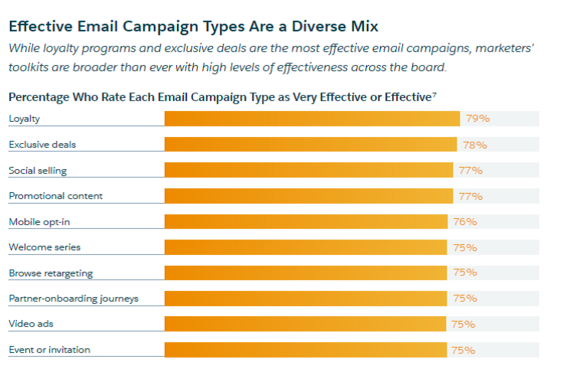
Figure 11: Effective email campaigns
43.Intelligent email is driving higher revenue - high performing marketing teams 4.2X more likely than underperforms to leverage data science for emails.
Social ROI
44.The link between social marketing and revenue increased 3X from 2015 to 2016 with nearly half of marketers (48%) reporting that social media marketing is directly linked to their business' primary source of revenue.
45.82% of marketers agree that social media marketing is core to their business.
46.39% of marketers report significant ROI generated from social media marketing, compared to only 9% in 2015.
47.Top marketing teams are 11X more likely than underperforms to be excellent at responding to social interactions in a timely manner.
48.Social listening and publishing go hand in hand for top marketing teams. High performing marketing teams are 8.6X more likely to use social listening tools extensively.
49.Social marketing meets social customer care - 84% of high performing marketing teams align their social media marketing strategy with other social activities such as customer service. This alignment is critical to delivering a seamless customer experience and show cross-company mindset for engaging with customers.
50.More than three-quarters of marketers agree that content marketing is core to their business.
51.High performing marketing teams are 3.4X more likely than underperforms to say content marketing generates significant ROI.
52.80% of high performing teams publish content at least 2-3 times per week, compared to 16% of underperformers.
Figure 12: Most popular social networks
Advertising Accelerates on Social Platforms
53.80% of high performing marketing teams will increase spending on advertising on social platforms.
54.At least two-thirds of marketers agree that digital advertising strategies are very effective or effective.
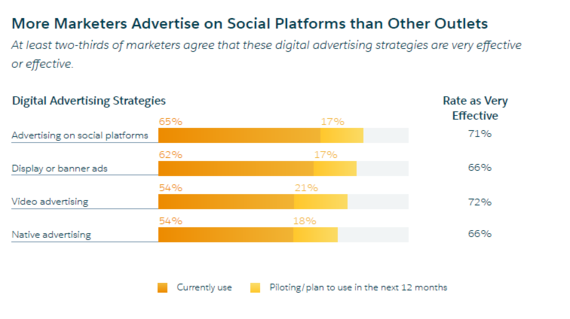
Figure 13: Advertising on social platforms on the rise
55.Data driven advertising take center stage - at least 70% of marketing leaders now use data to segment their advertising.
In summary, to become a high-performing marketer, the research recommends the 5 following actions:
- Adopt a customer journey
- Lead customer engagement company wide
- Align digital channels with overall marketing strategy
- Go mobile
- Target ads with customer data (lean into CRM)

